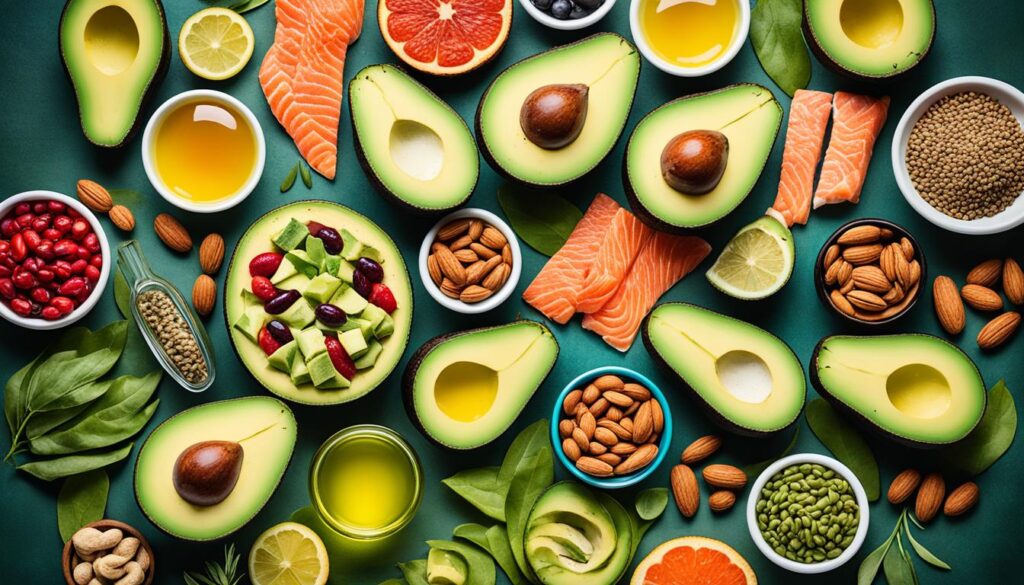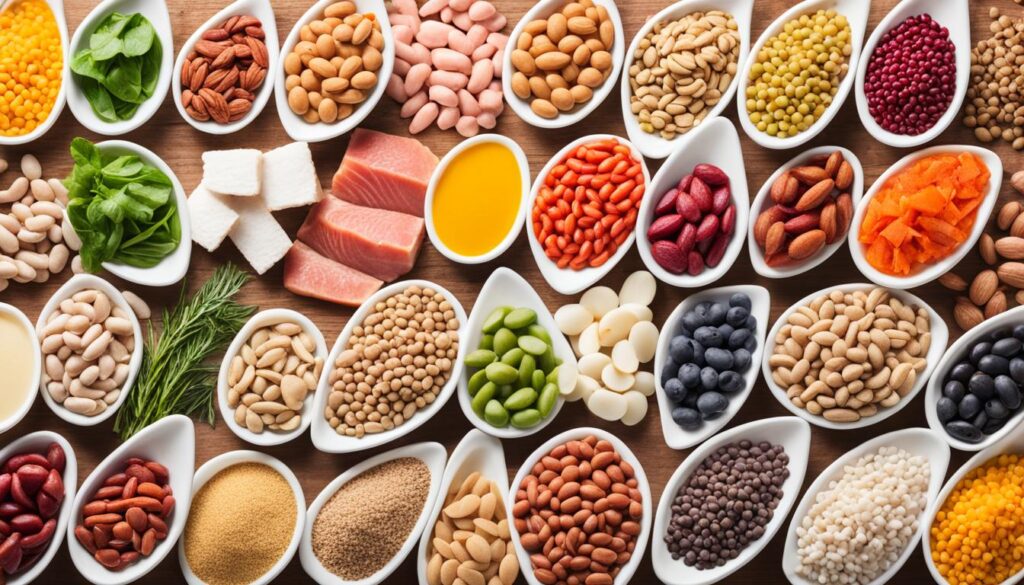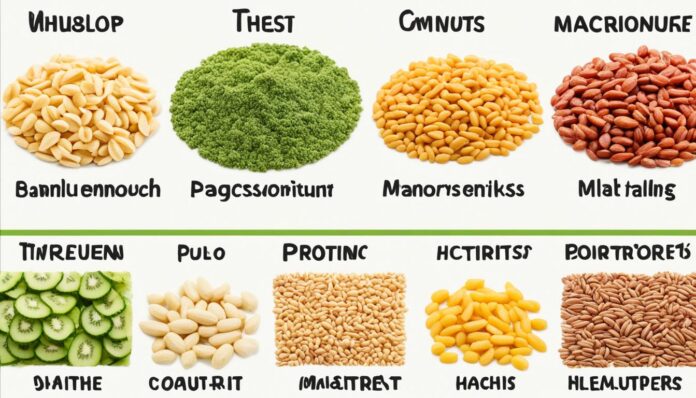What if we told you that the key to unlocking optimal health and fitness could be found in the very nutrients that provide your body with energy? Welcome to the world of macronutrients – the foundational building blocks that keep your body functioning at its best1.
In this comprehensive article, we’ll dive deep into the world of macronutrients, exploring the critical roles that proteins, carbohydrates, and fats play in maintaining your overall well-being. From understanding the different types of these essential nutrients to discovering the sources that offer the most nutritional bang for your buck, we’re about to embark on a journey that will empower you to make more informed choices for your health1.
Key Takeaways
- Macronutrients are the nutrients your body needs in large amounts, including carbohydrates, fats, and proteins.
- Carbohydrates are your body’s primary source of energy, while fats provide essential functions and unsaturated fats offer heart-healthy benefits1.
- Proteins are crucial for building and repairing cells, and obtaining a variety of high-quality protein sources is important1.
- Balancing your macronutrient intake is key for optimal health and fitness, and personalized approaches may be more effective than one-size-fits-all recommendations1.
- Focusing on overall diet quality, rather than individual macronutrients, is essential for achieving your health and wellness goals1.
What are Macronutrients?
Macronutrients are the essential nutrients your body needs in large amounts to function properly. These include carbohydrates, proteins, and fats2. These macronutrients provide your body with the energy it needs, measured in calories, where carbohydrates and proteins each provide 4 calories per gram, and fats provide 9 calories per gram2. Alcohol, while providing 7 calories per gram, is not considered a macronutrient as it is not necessary for survival2.
Macronutrients: The Nutrients Your Body Needs in Large Amounts
Macronutrients are the nutrients that your body requires in the greatest quantities to support overall health and well-being. They are the building blocks of your diet, providing the energy and essential components necessary for optimal bodily function. Understanding the role of each macronutrient is crucial for maintaining a balanced and nutritious diet3.
The Difference Between Macronutrients and Micronutrients
While macronutrients are the nutrients your body needs in large amounts, micronutrients are the vitamins and minerals your body requires in smaller quantities. Micronutrients are just as essential for your health, playing vital roles in various bodily processes, from immune function to bone health3. Ensuring an adequate intake of both macronutrients and micronutrients is key to achieving overall nutritional balance and supporting your body’s optimal performance3.
To summarize, macronutrients are the three main nutrients your body needs in large amounts: carbohydrates, proteins, and fats. These macronutrients provide your body with the energy it requires, while micronutrients, such as vitamins and minerals, are essential for supporting various bodily functions in smaller quantities234.
| Macronutrient | Calories per Gram | Recommended Intake |
|---|---|---|
| Carbohydrates | 4 | 45-65% of total calories |
| Proteins | 4 | 10-35% of total calories |
| Fats | 9 | 20-35% of total calories |
The recommended macronutrient intake can vary depending on individual needs and health goals34. Understanding the role and balance of macronutrients is crucial for maintaining a healthy, balanced diet that supports your overall well-being.
Carbohydrates: Your Body’s Main Energy Source
Carbohydrates are the primary fuel source for our bodies, providing the energy we need to function throughout the day. There are several different types of dietary carbohydrates, each with its own unique characteristics and health implications5.
Types of Dietary Carbohydrates: Sugars, Starches, and Fiber
Carbohydrates can be classified into three main categories: sugars, starches, and fiber6. Sugars are simple carbohydrates that are easily absorbed and can quickly provide a burst of energy. Starches, on the other hand, are complex carbohydrates that take longer to digest, releasing energy more gradually. Fiber is a type of carbohydrate that the body cannot break down but is essential for gut health and overall well-being6.
Best Sources of Carbohydrates: Unprocessed or Minimally Processed Foods
When it comes to carbohydrates, the healthiest sources are unprocessed or minimally processed foods like whole grains, fruits, vegetables, and legumes7. These foods are rich in essential nutrients, fiber, and other beneficial compounds that can support overall health. In contrast, refined and processed carbohydrates, such as those found in baked goods, sweets, and snack foods, often lack these vital nutrients and can contribute to weight gain and other health issues7.
To ensure you’re getting the most from your carbohydrate intake, aim to make whole, fiber-rich foods the foundation of your diet5. This not only supports your energy levels but also promotes a healthy gut, aids in weight management, and reduces the risk of chronic diseases7.
Understanding Fats: Essential for Health
Fats are a vital macronutrient that provide our bodies with energy, insulation, and support for various physiological functions8. There are three primary types of dietary fats: unsaturated fats, saturated fats, and trans fats9. Understanding the differences between these fats is crucial for maintaining a balanced and healthy diet.
Types of Dietary Fats: Unsaturated, Saturated, and Trans Fats
Unsaturated fats, which include monounsaturated and polyunsaturated fats, are generally considered the healthiest type of dietary fat9. These fats are typically liquid at room temperature and are found in foods such as avocados, nuts, seeds, and olive oil10. On the other hand, saturated fats, which come from sources like red meat, full-fat dairy, and poultry, can raise LDL (bad) cholesterol levels and increase the risk of heart disease10.
The third type of dietary fat, trans fats, are particularly concerning for health10. Commonly found in fried foods, margarine, and some baked goods, trans fats have been linked to an increased risk of heart disease and other chronic conditions9. Health experts recommend limiting or avoiding trans fats altogether as part of a balanced, nutritious diet.
Fats are an essential macronutrient, providing a dense source of energy for the body109. Consuming a moderate amount of healthy, unsaturated fats can support overall health, while limiting intake of saturated and trans fats is crucial for reducing the risk of chronic diseases.
“Fats are essential for good health, but the type of fat you consume matters. Focusing on unsaturated fats from plant-based sources can provide numerous benefits, while limiting saturated and trans fats is important for heart health.”
Best Sources of Healthy Fats
When it comes to maintaining a balanced and nutritious diet, healthy fats play a crucial role. Unsaturated fats, in particular, offer numerous health benefits, from supporting heart health to promoting brain function. The best sources of these beneficial fats include nuts, seeds, avocado, fatty fish, and olive oil.
Nuts, such as almonds, contain approximately 14.1g of healthy fats per 1 oz serving11. Seeds, like chia and flaxseeds, are also excellent sources, providing 8.7g and 42.2g of fat per serving, respectively11. Avocado, a nutrient-dense fruit, offers 14.7g of fat per 100g, predominantly in the form of monounsaturated fatty acids11.
Fatty fish, like salmon and mackerel, are rich in omega-3 fatty acids, which are essential for maintaining heart and brain health. The American Heart Association (AHA) recommends consuming 2 servings of fatty fish per week11. A 3-oz serving of fresh mackerel contains approximately 11.8g of fat and 15.8g of protein11.
Olive oil is another excellent source of healthy, unsaturated fats, containing 14g of fat per 1 tbsp11. Studies have shown that olive oil is associated with a lower risk of heart disease, making it a valuable addition to a balanced diet11.
While full-fat dairy products, such as natural yogurt, can also be part of a healthy fat intake, there is ongoing debate about the benefits of full-fat versus low-fat options11. It’s essential to be mindful of the overall macronutrient balance in your diet and to choose high-quality, minimally processed sources of healthy fats whenever possible.
“Unsaturated fats, particularly monounsaturated and polyunsaturated fats, play a vital role in fighting inflammation and maintaining overall health. These essential fats must be obtained from our diet.”
By incorporating these nutrient-dense, healthy fat sources into your meals and snacks, you can support your overall well-being and provide your body with the essential nutrients it needs to thrive11.

The Importance of Protein
Protein is a crucial macronutrient that plays a vital role in the human body. It is essential for growth, repair, and maintenance of tissues, as well as various metabolic functions12. Proteins are made up of long chains of smaller units called amino acids, some of which are considered “essential” because the body cannot produce them and they must be obtained through the diet12.
Complete and Incomplete Proteins: Meeting Your Essential Amino Acid Needs
Proteins can be categorized as either complete or incomplete13. Complete proteins, typically found in animal-based foods like meat, dairy, and eggs, contain all the essential amino acids13. Incomplete proteins, often found in plant-based sources like grains, legumes, and nuts, are missing one or more of the essential amino acids13. To ensure you meet your essential amino acid needs, it’s important to consume a variety of protein sources, both animal and plant-based13.
The recommended protein intake according to the Dietary Reference Intake Report is 0.36 grams of protein per pound of body weight14. An average sedentary man should consume around 56 grams of protein daily, while an average sedentary woman should consume around 46 grams daily14. The recommendation is to get between 10% and 35% of daily calories from protein, depending on physical activity level14.
“Consuming a variety of protein sources, both animal and plant-based, can help ensure you meet your essential amino acid needs.”
| Macronutrient | Recommended Intake |
|---|---|
| Carbohydrates | 45% to 65% of daily caloric intake14 |
| Fats | 20% to 35% of total daily caloric intake14 |
| Saturated Fats | Not to exceed 7% to 10% of the diet, mainly from animal sources and tropical oils14 |
| Trans Fats | Avoid completely due to their negative impact on cholesterol levels14 |
| Cholesterol | 300 grams or less daily for those with normal cholesterol levels, less than 200 grams for those with elevated cholesterol14 |
By understanding the importance of complete and incomplete proteins and how they contribute to meeting your essential amino acid needs, you can make informed choices to optimize your protein intake and support your overall health and well-being13.
High-Quality Protein Sources
When it comes to maintaining a balanced and nutritious diet, the choice of protein sources plays a crucial role. Protein is an essential macronutrient that serves numerous vital functions in the body, from building and repairing tissues to supporting immune function15. The National Academy of Medicine recommends a minimum of 0.8 grams of protein for every kilogram of body weight per day for adults15. For a person weighing 140 pounds, the recommended daily protein intake is about 50 grams, while for someone weighing 200 pounds, the recommendation is around 70 grams15.
When it comes to high-quality protein sources, both animal-based and plant-based options offer valuable nutrients. Animal proteins, such as meat, poultry, fish, eggs, and dairy, are considered complete proteins, as they contain all the essential amino acids your body needs16. Animal sources of protein can provide roughly 70% or more of calories from protein16. On the other hand, plant-based proteins, like tofu, tempeh, beans, lentils, and nuts, are often considered incomplete proteins, as they may lack one or more essential amino acids.
To ensure you’re getting a balanced intake of all the essential amino acids, it’s recommended to consume a variety of protein sources, both animal-based and plant-based15. Plant-based foods like beans, nuts, fish, or poultry are recommended as healthy protein sources over red meat and processed meat, lowering the risk of diseases and premature death15. Some excellent protein-rich options include:
- Tofu and tempeh15
- Beans, lentils, and chickpeas17
- Eggs and dairy products17
- Fish, such as tuna, salmon, and halibut17
- Lean poultry, like chicken and turkey17
- Lean red meat, such as beef and venison17
When selecting protein sources, it’s essential to consider not only the protein content but also the overall nutritional profile and environmental impact15. Animal-based food production has higher greenhouse gas emissions compared to plant-based foods, with red meat, especially beef, lamb, and goat, standing out for their disproportionate impact on the environment15. By incorporating a variety of high-quality protein sources into your diet, you can meet your body’s protein needs while also promoting overall health and sustainable food choices.

| Protein Source | Protein Content (per 8 oz/227 g serving) |
|---|---|
| Boneless/Skinless Chicken Breast | 52 g17 |
| Canned Solid White Albacore Tuna | 71 g17 |
| Lean Ground Turkey (99%) | 54 g17 |
| Venison Steak | 67.6 g17 |
| Beef Jerky | 120 g17 |
| Chickpeas | 170 g (per 1.7 kg)17 |
By incorporating a variety of high-quality, minimally processed protein sources into your diet, you can meet your body’s essential amino acid needs and support overall health and wellbeing15. Remember, it’s not just about the quantity of protein but also the quality and source that matters most15.
The production of one pound of lamb generates five times more greenhouse gas emissions than making a pound of chicken and around 30 times more than making a pound of lentils15.
Balancing Your Macronutrient Intake
Achieving the optimal balance of macronutrients – carbohydrates, proteins, and fats – is essential for overall health and fitness18. The USDA recommends a macronutrient split of 45-65% carbohydrates, 10-35% protein, and 20-35% fat18. However, the ideal macronutrient ratio can vary depending on individual factors and goals.
Worldwide estimates suggest that over 1 billion people have chronically insufficient protein intake, with up to 30% of children in central Africa and South Asia and over 50% of the homebound elderly population in the United States affected19. Conversely, chronic excess energy intake from carbohydrates and fats has been associated with weight gain, obesity, type 2 diabetes, hypertension, and other adverse health outcomes related to increased adiposity19.
- While macronutrients are not directly toxic even when consumed in large amounts, overfeeding on protein alone is not associated with increased adiposity; it can actually improve body composition, especially in individuals who engage in resistance exercise19.
- Essential fatty acid deficiency is rare in individuals with a regular diet but most frequently presents in individuals with severe fat malabsorption or fat-free parenteral nutrition, leading to dermatitis, alopecia, liver dysfunction, and increased susceptibility to infections19.
- Protein undernutrition is common in developed and developing countries with consequences ranging from mild to life-threatening, including stunting, anemia, cardiovascular dysfunction, muscle wasting, immunodeficiency, hypoalbuminemia, edema, and impaired hormone production19.
Working with a healthcare professional can help you determine the right macronutrient balance for your unique needs and goals. By understanding the importance of macronutrient balance, you can make informed choices to optimize your overall health and well-being.
The Role of Diet Quality
When it comes to optimizing your health, the focus should be on the overall quality of your diet rather than obsessing over individual macronutrients20. Studies have shown that weight change is most strongly associated with the intake of certain foods, such as potato chips, sugar-sweetened beverages, and processed meats20. On the other hand, high-quality foods like vegetables, whole grains, fruits, nuts, and yogurt are linked to weight loss20.
The key is to shift your attention from counting specific macros to embracing a balanced, nutrient-dense diet rich in minimally processed, whole foods21. These foods provide a harmonious blend of carbohydrates, proteins, and healthy fats that work together to support your overall health, rather than relying on a specific macronutrient ratio21. As research indicates, there is no one-size-fits-all optimal diet, as individual differences in genetics and lifestyle play a significant role20.
Focusing on Overall Dietary Patterns Rather Than Individual Nutrients
While specific macronutrient-based diets may be effective for some individuals, the evidence suggests that the quality of your overall dietary pattern is more important than the exact ratio of macronutrients20. A study comparing four weight-loss diets found that after one year, weight loss was greater for women in the Atkins diet group compared with other diet groups20. However, another study following 800 participants over 2 years showed comparable average weight loss among low-fat, high-protein, high-fat, and high-protein diet groups20.
Ultimately, the key to successful weight management and overall health lies in adopting a balanced, whole-food-based diet that nourishes your body with a variety of essential nutrients22. By shifting your focus from strict macronutrient counting to emphasizing the quality of your dietary patterns, you can unlock the true power of a nutritious and sustainable way of eating20.

| Nutrient | Calories per Gram |
|---|---|
| Carbohydrates | 4 kcal |
| Protein | 4 kcal |
| Fat | 9 kcal |
The World Health Organization recommends keeping saturated fat intake to 10% and trans fat intake to no more than 1% of total energy intake21. Essential amino acids in protein must come from the diet and are found in a variety of foods, including fish, poultry, meat, eggs, lentils, beans, nuts, and seeds21. Fiber-rich foods, such as those found in whole grains, vegetables, and fruits, can slow digestion, increase feelings of fullness, and help balance blood sugar2122.
Personalized Nutrition: Discovering Your Unique Response to Food
Our bodies are complex machines, each with its own unique set of needs and preferences. When it comes to nutrition, this individuality becomes even more pronounced. Recent research has shown that a person’s response to food is heavily influenced by factors like their gut microbiome, age, weight, and underlying health conditions23. Programs like ZOE are revolutionizing the way we approach personalized nutrition, empowering individuals to discover how their bodies react to different foods and macronutrient combinations24.
Nutrigenomic testing, for instance, can evaluate more than 70 specific genes related to chronic diseases, metabolic processes, and food preferences24. By analyzing an individual’s unique genetic makeup, these tests can provide customized dietary and lifestyle recommendations tailored to their specific needs. In the Habit Study, participants experienced significant reductions in calorie intake, carbohydrates, sugars, total fat, and saturated fat over a 10-week personalized systems nutrition program, with those showing compromised metabolic flexibility seeing notable improvements in their LDL cholesterol and total cholesterol levels24.
The Food4Me study further reinforces the benefits of personalized nutrition, revealing that personalized advice led to more significant and sustained changes in eating behavior compared to standard dietary recommendations after six months24. Interestingly, the study also found that including more complex phenotypic and genotypic information did not significantly enhance the benefits of personalized nutrition advice24.
- Genetic differences can predispose individuals to lose different amounts of weight on various diets25.
- Initial research suggested DNA-based diets could be effective, but subsequent studies found no significant weight loss difference between following genotype-specific diets and non-genotype-specific diets25.
- The impact of genes on obesity varies, with estimates ranging from 35% to 85%25.
- Variations in individual responses to different diets have been observed by nutritionists, highlighting the need for personalized nutrition approaches25.
The “Predict” study, conducted by researchers at King’s College, London, and Harvard Medical School, revealed surprising differences in how individuals process fats and carbohydrates25. The study showed that metabolic efficiency for one macronutrient does not predict how an individual might respond to another macronutrient, signifying a significant milestone in personalized nutrition research and moving towards tailored diet recommendations for individuals25.
“Personalized nutrition plans have been shown to improve metabolic health, weight management, and reduce the risk of certain diseases according to scientific studies.”24
As we continue to unravel the complexities of human nutrition, the future of personalized nutrition holds immense promise. By understanding our unique responses to food, we can create customized plans that optimize our health, well-being, and overall quality of life232425.
Understanding Macronutrients: Proteins, Carbs, and Fats
Macronutrients – carbohydrates, proteins, and fats – are the three primary nutrients your body requires in large quantities. These essential components provide energy, support various bodily functions, and play a crucial role in maintaining overall health. Understanding the different types and sources of macronutrients can help you make informed choices to create a balanced, nutritious diet.
Carbohydrates and protein each contribute 4 calories per gram, while fats contribute 9 calories per gram26. Proteins are composed of amino acids, with the body requiring 20 different amino acids for optimal functioning, 11 of which are produced by the body. There are 9 essential amino acids that must be obtained through protein sources in food26. Fats are made up of fatty acids and glycerol, and essential fatty acids like linoleic acid and alpha-linolenic acid must be obtained from dietary sources26.
The recommended dietary allowance suggests 0.8 grams of protein per kilogram of body weight per day for the average adult, while athletes might need up to 2.0 grams of protein per kilogram of body weight27. Consuming too many grams of unhealthy fats per day can increase the risk of heart disease and stroke while reducing immune system functioning. About 20% of the diet should be comprised of healthy fats26.
Examples of healthy fat sources include avocados, almonds, walnuts, seeds, and oils like olive oil and coconut26. The body needs about 45 to 65% of its calories to come from carbohydrates, while the recommended daily protein intake for adults is between 46-56 grams27.
Understanding the right amount of macronutrients is crucial for maintaining health and achieving fitness goals. Focusing on macronutrients instead of calories is a trend in weight loss, with diets like IIFYM (If It Fits Your Macros) guiding people to calculate their daily intake of protein, carbs, and fats26.
| Macronutrient | Calorie Contribution | Recommended Intake | Healthy Sources |
|---|---|---|---|
| Carbohydrates | 4 calories per gram | 45-65% of total calories | Fruits, vegetables, whole grains |
| Protein | 4 calories per gram | 0.8-2.0 g/kg body weight | Lean meats, poultry, fish, eggs, legumes |
| Fats | 9 calories per gram | 20-35% of total calories | Nuts, seeds, avocados, olive oil |
Ultimately, the calculation of macronutrient distribution should be based on individual caloric needs and goals, which can vary depending on factors such as activity level and genetics28. Seeking guidance from a registered dietitian can help determine personalized macronutrient needs and develop a balanced, nutritious diet plan28.
Reading Nutrition Labels: Evaluating Protein and Sugar Content
Understanding the information on nutrition labels is crucial for making informed food choices and maintaining a healthy diet. When evaluating food products, it’s important to pay close attention to the protein and sugar content.
The grams of protein listed on the nutrition label are essential for repairing tissues, supporting muscle growth, and maintaining a healthy immune system29. Ideally, the grams of protein should be higher than the grams of sugar or total sugars, as foods high in sugar but low in protein tend to digest quickly and can contribute to weight gain and cravings30.
Aim for food products with 8 grams or less of sugar per serving30. Excessive consumption of added sugars is linked to health issues such as obesity, diabetes, and heart disease29. Look for alternative names for sugar on the ingredients list, such as agave nectar, cane juice, or malt syrup, to identify sources of added sugars29.
| Nutrient | 1 Serving | 2 Servings |
|---|---|---|
| Calories | 280 | 560 |
| Protein | 15g | 30g |
| Total Sugars | 6g | 12g |
| Sodium | 37% DV | 74% DV |
The sample nutrition label information shows that one serving of frozen lasagna contains 280 calories, 15g of protein, and 6g of total sugars30. Consuming two servings would double these values to 560 calories, 30g of protein, and 12g of total sugars30. The sodium content is also high, with 37% of the daily value in one serving and 74% in two servings30.
Overall, reading and understanding nutrition labels can help you make healthier food choices, balance your macronutrient intake, and ensure you’re meeting your nutritional needs2931. By prioritizing protein and limiting added sugars, you can support your overall health and well-being.
Conclusion
In conclusion, understanding macronutrients – carbohydrates, proteins, and fats – and how they impact your health and fitness is crucial for making informed dietary choices32. Carbohydrates are noted as the primary source of energy, emphasizing their significant role in providing fuel for the body32, while proteins are highlighted as essential for tissue growth and repair, with various sources like lean meats, poultry, fish, dairy products, legumes, and plant-based substitutes32. Fats are identified as vital elements in a balanced diet, with distinctions between trans fats, unsaturated fats, and saturated fats, and emphasis on consuming beneficial fats like those found in avocados, nuts, seeds, and fatty fish.
By focusing on high-quality, minimally processed sources of each macronutrient and finding the right balance that works for your unique body, you can support your overall wellbeing and achieve your health and fitness goals33. Macronutrient ratios can be adjusted based on individual health goals and needs, emphasizing a personalized approach to macronutrient balance, and33 quality of macronutrients is crucial, with lean proteins, complex carbohydrates, and healthy fats being recommended choices to support overall health, promote satiety, and aid in weight management.
34 Carbohydrates are the body’s main source of energy and break down into glucose for energy34, while protein is essential for muscle growth, immune function, hormone production, and digestion, and34 fats are the most concentrated form of energy and help keep the skin and hair healthy, and aid in growth and development. By understanding the role of these macronutrients and incorporating them into a balanced, nutrient-dense diet, you can optimize your overall health and wellness.
FAQ
What are macronutrients?
Macronutrients are the three main nutrients your body needs in large amounts: carbohydrates, proteins, and fats. These macronutrients provide your body with energy measured in calories.
What is the difference between macronutrients and micronutrients?
Macronutrients are the nutrients your body needs in large amounts, while micronutrients are the vitamins and minerals your body requires in smaller amounts, but are still essential for optimal health.
What are the different types of dietary carbohydrates?
The three main types of dietary carbohydrates are sugars, starches, and fiber. Sugars are simple carbs that are easily absorbed, while starches are complex carbs that take longer to digest. Fiber is a type of carbohydrate that the body cannot break down but is essential for gut health.
What are the different types of dietary fats?
The three main types of dietary fats are unsaturated fats (monounsaturated and polyunsaturated), saturated fats, and trans fats. Unsaturated fats are generally considered the healthiest, while trans fats should be avoided.
What are the best sources of healthy, unsaturated fats?
The best sources of healthy, unsaturated fats include nuts, seeds, avocado, fatty fish like salmon and mackerel, and plant-based oils like olive, avocado, and nut oils.
What is the difference between complete and incomplete proteins?
Complete proteins contain all the essential amino acids, while incomplete proteins are missing one or more. Consuming a variety of protein sources, both animal and plant-based, can help ensure you meet your essential amino acid needs.
What is the recommended macronutrient split for a healthy diet?
The USDA recommends a macronutrient split of 45-65% carbohydrates, 10-35% protein, and 20-35% fat. However, the optimal macronutrient ratio can vary depending on individual factors and goals.
Why is it important to focus on the overall quality of your diet rather than just macronutrient ratios?
A healthy diet should be rich in minimally processed, nutrient-dense foods like whole grains, fruits, vegetables, nuts, seeds, and fermented foods. These foods provide a balance of macronutrients and micronutrients that work together to support optimal health, rather than relying on a specific macronutrient ratio.
How can personalized nutrition help individuals achieve their health and fitness goals?
Research shows that each person’s response to food is unique, influenced by factors like their gut microbiome, age, weight, and any underlying health conditions. Programs like ZOE can help individuals discover how their body responds to different foods and macronutrient combinations, allowing them to create a personalized nutrition plan for optimal health and wellbeing.
What should I look for when evaluating the nutrition label of a food product?
When evaluating nutrition labels, it’s important to pay attention to the protein and sugar content of food products. The grams of protein should be higher than the grams of sugar or total sugar, as foods high in sugar but low in protein tend to digest quickly and can contribute to weight gain and cravings. Aim for food products with 8 grams or less of sugar per serving.
Source Links
- What To Know About Macronutrients: Carbs, Fat, Protein
- Microsoft Word – Macronutrients.doc
- No title found
- Macronutrients 101: Understanding Carbs, Proteins, and Fats
- Carbohydrates: Getting the Most Out Of Fiber, Starches & Sugars
- Carbohydrates: MedlinePlus
- Choose your carbs wisely
- Understanding Macronutrients: Carbohydrates, Proteins, and Fats – Trainest
- Dietary Fats
- Protein, Carbs, and Fats: A Quick Overview | ISSA
- Healthy fats: 12 high fat foods to eat
- Understanding Macronutrients: Fat, Carbs & Protein | sk:n clinics
- A Complete Guide to Macronutrients for Fitness Beginners
- What Are Macronutrients?
- Protein
- 50 High Protein Foods to Help You Hit Your Macros
- Top 15 Healthy Carb, Protein, and Fat Rich Foods
- Balancing Macros: Protein, Carbs, and Fats in Your Diet
- Nutrition: Macronutrient Intake, Imbalances, and Interventions – StatPearls
- The Best Diet: Quality Counts
- Here’s why food quality is more important for fat loss than counting macros
- Here’s How Tracking Macros Can Help You Achieve Your Weight Loss Goals
- Personalized Diets based on the Gut Microbiome as a Target for Health Maintenance: from Current Evidence to Future Possibilities
- No title found
- Diet for One? Scientists Stalk the Dream of Personalized Nutrition (Published 2019)
- What Are Macronutrients? Understanding Protein, Carbs, And Fats | Biostrap
- Understanding Macronutrients: Proteins, Carbs, Fats Explained
- What Are Macros? Counting Proteins, Carbohydrates, and Fats – GoodRx
- How to Read and Understand Nutrition Labels
- How to Understand and Use the Nutrition Facts Label
- How to Read a Nutrition Label – ReDefineRVA
- Understanding Macronutrients: Carbohydrates, Proteins, and Fats
- Unlocking Optimal Health: Understanding Macronutrients for Wellness and Nutrition Balance
- Carbs, Protein, and Fats: Understanding Macronutrients



